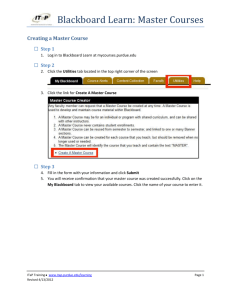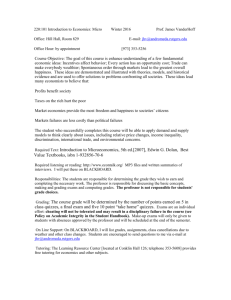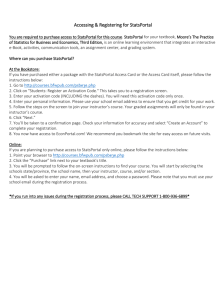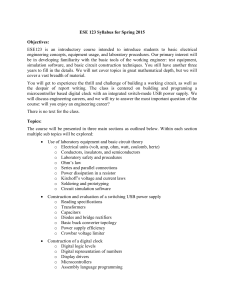Syllabus (temporary)
advertisement
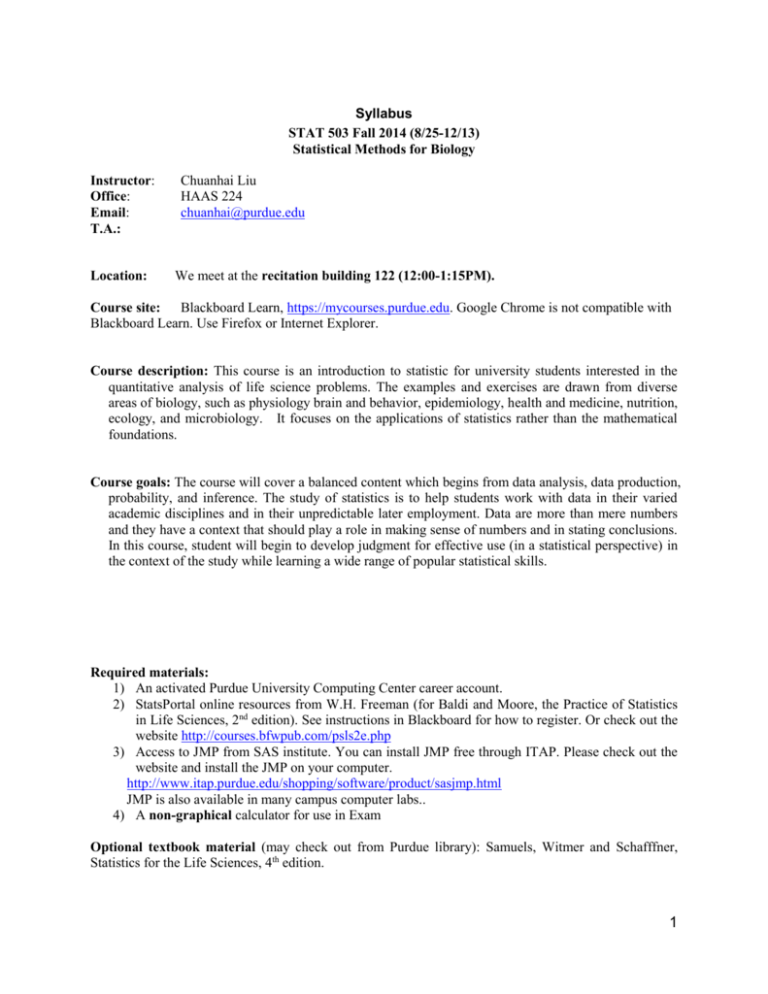
Syllabus STAT 503 Fall 2014 (8/25-12/13) Statistical Methods for Biology Instructor: Office: Email: T.A.: Location: Chuanhai Liu HAAS 224 chuanhai@purdue.edu We meet at the recitation building 122 (12:00-1:15PM). Course site: Blackboard Learn, https://mycourses.purdue.edu. Google Chrome is not compatible with Blackboard Learn. Use Firefox or Internet Explorer. Course description: This course is an introduction to statistic for university students interested in the quantitative analysis of life science problems. The examples and exercises are drawn from diverse areas of biology, such as physiology brain and behavior, epidemiology, health and medicine, nutrition, ecology, and microbiology. It focuses on the applications of statistics rather than the mathematical foundations. Course goals: The course will cover a balanced content which begins from data analysis, data production, probability, and inference. The study of statistics is to help students work with data in their varied academic disciplines and in their unpredictable later employment. Data are more than mere numbers and they have a context that should play a role in making sense of numbers and in stating conclusions. In this course, student will begin to develop judgment for effective use (in a statistical perspective) in the context of the study while learning a wide range of popular statistical skills. Required materials: 1) An activated Purdue University Computing Center career account. 2) StatsPortal online resources from W.H. Freeman (for Baldi and Moore, the Practice of Statistics in Life Sciences, 2nd edition). See instructions in Blackboard for how to register. Or check out the website http://courses.bfwpub.com/psls2e.php 3) Access to JMP from SAS institute. You can install JMP free through ITAP. Please check out the website and install the JMP on your computer. http://www.itap.purdue.edu/shopping/software/product/sasjmp.html JMP is also available in many campus computer labs.. 4) A non-graphical calculator for use in Exam Optional textbook material (may check out from Purdue library): Samuels, Witmer and Schafffner, Statistics for the Life Sciences, 4th edition. 1 Additional examples: If you need additional examples after the lecture or watching the lecture video, remember that on StatsPortal there are Stat Tutor video series with more problem-solving. You can also do some odd-numbered problems in your book (which has answers in the back). Course components and weights: Class activity/participation Assignment Midterm Exam Practical skill test Final Exam 5% 30% 25% 10% 30% ___________________________________________________ Total 100% StatsPortal Learning curve as extra credit: Piazza participation as extra credit 3% 1-2% Grades and scales 92— 100 A 89— 91 A- 87—88 82—86 79—81 B+ B B- 77—78 72—76 69—71 C+ C C- 67—68 62—66 59—61 D+ D D- 0-58 F Assignments: Typically, each assignment has two sections: conceptual and practical questions. The proportion of question depends on the content and is not necessarily 50-50. Conceptual questions focus on concept and theory understanding. They usually need to be completed using standard statistical notations and formulas. Mild hand computation is involved. For conceptual questions, you should use appropriate stat notations to present the question, then show the formulas with which you get the answer, finally highlight and interpret the answer. You can type or write the answer on a paper then scan, as long as the answers are clear and clean (see below for details). Practical questions focus on application skills to analyze data. You will learn to use JMP, a software that originated from SAS. For practical questions, you should include appropriate and (just the) relevant output. For example, the raw data is not a relevant output, but the statistical summary of the data could be. Graphs should always be included, with a clear title and labels. You should always interpret your output or graphs. That is, simply copying the output without your own narrative is considered an incomplete submission. 2 [For Example] in a hypothesis test problem, you should high light the p-value and judge why it approves or disapproves the statistical significance; then conclude in the context of the original problem. That is, not just saying “we reject the hypothesis, period”, but “there is no statistical evidence that the height is taller than 6 ft, which is possibly because [a logical explanation must present here]”. Assignments are posted on Blackboard in a weekly base. They are usually due on Tuesdays, or on the date stated in the homework. You need to submit the assignment through Blackboard. The assignment will be graded zero if 1) The document cannot be opened in blackboard or wrong document is submitted; 2) The submission is late; 3) The grader cannot recognize your handwriting or the scan quality is poor; 4) The student updated pictures taken by iPhone/pad, web cam, or cameras, which is hard for the grade to read. 5) Multiple submissions exist that look identical or very similar. Please check out the “examples of good vs bad assignment format” in the blackboard. Midterm and Final Exams: 1) You need to be present in person to take the exams 2) The exams will be closed book/closed notes exams. 3) The exams may contain multiple choice, matching, short answer, show-your-work, problem-solving, and reading comprehension questions. 4) You will be allowed to bring pencils, a non-graphical calculator, and ONE one-page cheat sheet (8 1/2" x 11", handwritten, both sides) to each exam. 5) Midterm exam will last about one hour and fifteen minutes, and the Final Exam will last two hours. 6) Work or Forgetting about an exam is never a valid excuse for missing exams. 7) Midterm exam is scheduled on Tuesday, Oct 21, 12:00pm – 1:15pm, in Recitation Building 122. 8) Final exam is also held on campus and will be announced later. Practical skill test Practical skill test is scheduled on evening Thursday, Dec 4. The test is open book and open note, but must be completed independently. Questions are announced at 8:00pm and submission must be accepted in Blackboard by 9:30pm. In the test, you need to solve problems with JMP. The submission format is the same as the practical question in the assignment. StatsPortal Learning Curve Learning Curve at StatsPortal are assigned as extra credit, for up to 3% credit for the course. LearningCurve is a formative assessment activity that uses a game-like interface to guide students through a series of questions catered to their individual level of understanding. Along the way and 3 after they complete the activity, students are directed to the specific resources they need to succeed in the course. For more details, please check out the Learning curve student FAQ at StartsProtal (click the LearningCurve icon after log in). LearningCurve quiz is also a great way to review and learn new knowledge from the textbook. Students need to achieve certain points to complete each quiz. This extra credit will be stored in StatsPortal then transferred into Blackboard’s gradebook at the end of the semester. There are only two due dates for the learning curve, one is Oct 20th, and the other is Dec 5th. You can check the scores in StatsPortal, but understand that they will not be moved into Blackboard’s gradebook. Frequently asked questions: 1. How to get an A for the class? Plan time for this course. A standard is about 3-4 hours each week. But if you always spend double the time in 2 or 3 weeks, let me know! Use the lecture video right: o Preview the video before class and prepare questions to ask later. o Review the video after class if needed. o Pause the video and try out the examples, then resume to check out the answer. Check out more examples (additional video) from StatsPortal>resources. 2. Why don’t I let you print off the PowerPoint slides with full details (solutions to examples) Well, besides the copyright issue, it is also for your own good that you should take your own notes. Check out the following link: http://www.facultyfocus.com/articles/teaching-professor-blog/tips-for-developingstudents-note-taking-skills/ to a short article that explains some research that has been done on student learning when they takes their own notes vs printing off slides. 3. Will I get an email reminder for all the due dates? Not really, reminders will only be sent out for midterm and final exams, changes in the schedule, or when a special material is added. 4. What kind of calculators do we need for the midterm or final exam? 4 Use non-graphical calculators; no phones, pads or computers are allowed. o The Texas Instruments TI-83 calculator is Okay. You need to know how to get the standard deviation efficiently with your calculator. 5. Do I have to be on campus to take the exam? Taking the exam on campus on the designated time is the best option. Final exam is organized by Purdue and cannot be rescheduled. If you want to schedule a makeup midterm exam, you must notify me a week ahead. Note that the alternative slots are limited or the make exam could be very different from others. Fail to show up in the exam will result in a zero in the test. 6. Other questions? Please send me an email. 5
